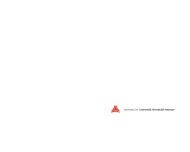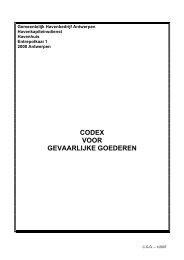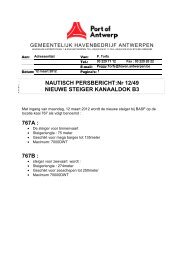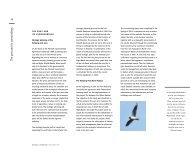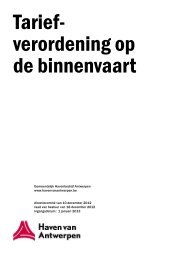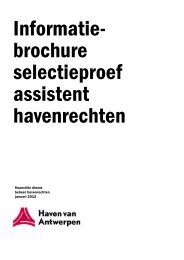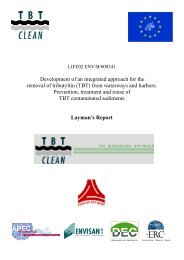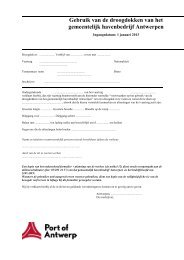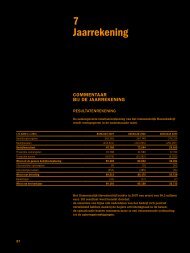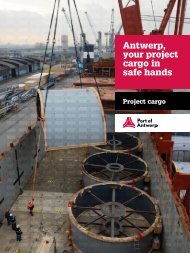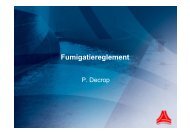PSC Controle op de kwaliteit van de bunkers - Port of Antwerp
PSC Controle op de kwaliteit van de bunkers - Port of Antwerp
PSC Controle op de kwaliteit van de bunkers - Port of Antwerp
You also want an ePaper? Increase the reach of your titles
YUMPU automatically turns print PDFs into web optimized ePapers that Google loves.
1<br />
1
FOD Mobiliteit en Vervoer – Maritiem Vervoer<br />
Scheepvaartcontrole<br />
Bunkeringproblematiek<br />
Overlegdag<br />
Kapt. P. Janssen, adviseur<br />
<strong>Antwerp</strong>en,<br />
Dienstho<strong>of</strong>d havenstaatscontrole België 1 april 2010<br />
2
FOD Mobiliteit en Vervoer – Maritiem Vervoer<br />
Scheepvaartcontrole<br />
De bescherming <strong>van</strong> het mariene milieu wordt in <strong>de</strong> EU<br />
geregeld door:<br />
‣ <strong>de</strong> geamen<strong>de</strong>er<strong>de</strong> IMO Marpol 73/78 Conventie<br />
‣ meer<strong>de</strong>re EU Richtlijnen, waaron<strong>de</strong>r RL 2009/16/EG<br />
(<strong>PSC</strong>), RL 2000/59/EG (scheepsafval) en <strong>de</strong> RL<br />
1999/32/EG (zwavelgehalte in scheepsbrandst<strong>of</strong>fen)<br />
zoals geamen<strong>de</strong>erd door RL 2005/33/EG<br />
3
FOD Mobiliteit en Vervoer – Maritiem Vervoer<br />
Scheepvaartcontrole<br />
Door <strong>de</strong> ratificatie <strong>van</strong> <strong>de</strong> Marpol Conventie en <strong>de</strong><br />
omzetting naar Belgisch recht <strong>van</strong> <strong>de</strong> EU richtlijnen<br />
wordt <strong>de</strong> dienst “Scheepvaartcontrole” <strong>van</strong> <strong>de</strong> FOD<br />
Mobiliteit en Vervoer bevoegd voor <strong>de</strong> controles <strong>op</strong><br />
een correcte naleving <strong>van</strong> <strong>de</strong>ze reglementen.<br />
4
FOD Mobiliteit en Vervoer – Maritiem Vervoer<br />
Scheepvaartcontrole<br />
De controles aan boord <strong>van</strong> <strong>de</strong> schepen bestaan uit:<br />
‣ controle <strong>van</strong> certificaten, documenten en journaals<br />
‣ nazicht <strong>van</strong> <strong>de</strong> technische installaties zoals <strong>de</strong> OWS<br />
(olie/water afschei<strong>de</strong>r), ODME (tankers) en<br />
verbrandingsinstallaties<br />
‣ controle <strong>op</strong> <strong>de</strong> emissies <strong>van</strong> schepen/ <strong>de</strong> <strong>kwaliteit</strong> <strong>van</strong><br />
<strong>de</strong> <strong>bunkers</strong><br />
5
FOD Mobiliteit en Vervoer – Maritiem Vervoer<br />
Scheepvaartcontrole<br />
<strong>Controle</strong> <strong>op</strong> <strong>de</strong> emissies <strong>van</strong> schepen<br />
‣ Marpol Annex VI <strong>kwaliteit</strong>snormen voor scheepsbrandst<strong>of</strong>fen<br />
en het gebruik <strong>van</strong> stookolie met een<br />
maximum zwavelgehalte <strong>van</strong> 1,50% zwavel in <strong>de</strong><br />
ECA zones (Emission Control Areas)<br />
‣ RL 2005/33/EG in EU havens afgemeer<strong>de</strong> schepen<br />
mogen sinds 01/01/2010 enkel nog LSGO met een<br />
maximum zwavelgehalte <strong>van</strong> 0,10% zwavel<br />
verbran<strong>de</strong>n<br />
6
FOD Mobiliteit en Vervoer – Maritiem Vervoer<br />
Scheepvaartcontrole<br />
Marpol Annex VI - <strong>Controle</strong> <strong>op</strong> <strong>de</strong> emissies <strong>van</strong> schepen<br />
Er zijn 3 manieren aanvaard om <strong>de</strong> uitstoot <strong>van</strong> SOx te<br />
beperken in ECA zones<br />
‣ brandst<strong>of</strong> met maximaal 1,50 % zwavel m/m, <strong>of</strong><br />
‣ een goedgekeurd “exhaust gas cleaning system”, <strong>of</strong><br />
‣ een an<strong>de</strong>re goedgekeur<strong>de</strong> en controleerbare technologie.<br />
7
FOD Mobiliteit en Vervoer – Maritiem Vervoer<br />
Scheepvaartcontrole<br />
Marpol Annex VI - controle <strong>op</strong> <strong>de</strong> emissies <strong>van</strong> schepen<br />
en <strong>de</strong> <strong>kwaliteit</strong> <strong>van</strong> <strong>de</strong> <strong>bunkers</strong><br />
‣ <strong>kwaliteit</strong>snormen voor alle a/b gelever<strong>de</strong> brandst<strong>of</strong>fen<br />
‣ een brandst<strong>of</strong>leveringsnota (bunker <strong>de</strong>livery note) die<br />
informatie verschaft over <strong>de</strong> gelever<strong>de</strong> brandst<strong>of</strong><br />
‣ <strong>de</strong> bunkerleverancier levert ook een “MARPOL bunker<br />
monster” af<br />
8
FOD Mobiliteit en Vervoer – Maritiem Vervoer<br />
Scheepvaartcontrole<br />
Marpol Annex VI - controle <strong>op</strong> <strong>de</strong> <strong>kwaliteit</strong> <strong>van</strong> <strong>de</strong> <strong>bunkers</strong><br />
Bunker Delivery Note (BDN)<br />
‣ <strong>de</strong> BDN is een door <strong>de</strong> leverancier on<strong>de</strong>rteken<strong>de</strong> verklaring<br />
waarbij hij bevestigt dat <strong>de</strong> brandst<strong>of</strong> werd geleverd volgens<br />
<strong>de</strong> bepalingen <strong>van</strong> <strong>de</strong> regels 14 (SOx) en 18 (<strong>kwaliteit</strong> <strong>van</strong> <strong>de</strong><br />
brandst<strong>of</strong>) <strong>van</strong> Marpol Annex VI<br />
‣ <strong>de</strong> BDN wordt door zowel het schip als <strong>de</strong> leverancier 3 jaar<br />
bewaard<br />
9
FOD Mobiliteit en Vervoer – Maritiem Vervoer<br />
Scheepvaartcontrole<br />
Marpol Annex VI - controle <strong>op</strong> <strong>de</strong> <strong>kwaliteit</strong> <strong>van</strong> <strong>de</strong> <strong>bunkers</strong><br />
Bunker Delivery Note (BDN)<br />
De BDN vermeldt volgen<strong>de</strong> gegevens:<br />
• naam en IMO nummer <strong>van</strong> het zeeschip<br />
• haven<br />
• datum <strong>van</strong> <strong>de</strong> levering<br />
• naam, adres en telefoonnummer <strong>van</strong> <strong>de</strong> brandst<strong>of</strong>leverancier<br />
• naam <strong>van</strong> <strong>de</strong> gelever<strong>de</strong> producten<br />
• hoeveelheid in metrische tonnen<br />
• <strong>de</strong>nsiteit bij 15°C (kg/m 3 )<br />
• zwavelgehalte (% m/m)<br />
10
FOD Mobiliteit en Vervoer – Maritiem Vervoer<br />
Scheepvaartcontrole<br />
Marpol Annex VI - controle <strong>op</strong> <strong>de</strong> <strong>kwaliteit</strong> <strong>van</strong> <strong>de</strong> <strong>bunkers</strong><br />
Marpol “bunker monster”<br />
‣ samen <strong>de</strong> BDN wordt ook een representatief monster <strong>van</strong> <strong>de</strong><br />
gelever<strong>de</strong> brandst<strong>of</strong> aan het zeeschip afgeleverd<br />
‣ het monster wordt verzegeld en bei<strong>de</strong> partijen (schip en<br />
leverancier) en tekenen het af<br />
‣ het monster wordt aan boord <strong>van</strong> het zeeschip bewaard tot <strong>de</strong><br />
brandst<strong>of</strong> is verbruikt maar in ie<strong>de</strong>r geval voor een perio<strong>de</strong><br />
<strong>van</strong> minstens 12 maan<strong>de</strong>n na levering.<br />
‣ IMO richtlijn [Res. MEPC.96(47)] voor het bemonsteren<br />
11
FOD Mobiliteit en Vervoer – Maritiem Vervoer<br />
Scheepvaartcontrole<br />
Marpol Annex VI - controle <strong>op</strong> <strong>de</strong> <strong>kwaliteit</strong> <strong>van</strong> <strong>de</strong> <strong>bunkers</strong><br />
IMO Res. MEPC.96(47) voor het bemonsteren<br />
Bemonsteren moet gebeuren aan het bunker manifold <strong>van</strong> het<br />
ont<strong>van</strong>gen<strong>de</strong> zeeschip en 3 manieren om het te doen:<br />
‣ manueel bedien<strong>de</strong> “continuous-drip sampler” afsluiter, <strong>of</strong><br />
‣ “time-pr<strong>op</strong>ortional” automatische bemonstering, <strong>of</strong><br />
‣ “flow-pr<strong>op</strong>ortional” automatische bemonstering<br />
12
FOD Mobiliteit en Vervoer – Maritiem Vervoer<br />
Scheepvaartcontrole<br />
Marpol Annex VI - controle <strong>op</strong> <strong>de</strong> <strong>kwaliteit</strong> <strong>van</strong> <strong>de</strong> <strong>bunkers</strong><br />
IMO Res. MEPC.96(47) voor het bemonsteren<br />
‣ Het Marpol monster moet voldoen<strong>de</strong> groot om er <strong>de</strong> nodige<br />
tests <strong>op</strong> te kunnen doen en moet minstens 400 ml zijn.<br />
‣ De container zou voor 90% gevuld moeten zijn met een marge<br />
<strong>van</strong> 5% min/meer.<br />
‣ De bunkerleverancier is verantwoor<strong>de</strong>lijk voor het verzegelen<br />
in aanwezigheid <strong>van</strong> <strong>de</strong> ont<strong>van</strong>ger.<br />
13
FOD Mobiliteit en Vervoer – Maritiem Vervoer<br />
Scheepvaartcontrole<br />
Marpol Annex VI - controle <strong>op</strong> <strong>de</strong> <strong>kwaliteit</strong> <strong>van</strong> <strong>de</strong> <strong>bunkers</strong><br />
IMO Res. MEPC.96(47) voor het bemonsteren<br />
Het label <strong>van</strong> het monster moet het volgen<strong>de</strong> vermel<strong>de</strong>n:<br />
• plaats waar genomen en <strong>de</strong> metho<strong>de</strong> <strong>van</strong> bemonsteren<br />
• datum <strong>van</strong> aan<strong>van</strong>g levering<br />
• naam <strong>van</strong> <strong>de</strong> bunkerboot <strong>of</strong> bunker installatie<br />
• naam en IMO nummer <strong>van</strong> het zeeschip<br />
• handtekeningen en naam <strong>van</strong> <strong>de</strong> leverancier en <strong>de</strong> ont<strong>van</strong>ger<br />
• i<strong>de</strong>ntificatie <strong>de</strong>tails <strong>van</strong> <strong>de</strong> verzegeling, en<br />
• soort <strong>van</strong> gelever<strong>de</strong> brandst<strong>of</strong><br />
14
FOD Mobiliteit en Vervoer – Maritiem Vervoer<br />
Scheepvaartcontrole<br />
<strong>PSC</strong> <strong>Controle</strong> <strong>op</strong> <strong>de</strong> <strong>kwaliteit</strong> <strong>van</strong> <strong>de</strong> <strong>bunkers</strong> - Marpol Annex VI<br />
Hebben <strong>de</strong> schepen <strong>de</strong> juiste brandst<strong>of</strong> (LSFO max. 1,50% S)<br />
aan boord en werd er tijdig overgeschakeld?<br />
De BDN (Bunker Delivery Note) wordt nagekeken en het<br />
verbruik <strong>van</strong> <strong>de</strong> LSFO wordt gecontroleerd aan <strong>de</strong> hand <strong>van</strong><br />
<strong>de</strong> gegevens uit het machinejournaal en eventueel ook door<br />
peilingen <strong>van</strong> <strong>de</strong> brandst<strong>of</strong>tanks.<br />
Bij twijfel volgt er een monstername en analyse door een door<br />
<strong>de</strong> FOD erkend laboratorium.<br />
15
FOD Mobiliteit en Vervoer – Maritiem Vervoer<br />
Scheepvaartcontrole<br />
<strong>PSC</strong> <strong>Controle</strong> <strong>op</strong> <strong>de</strong> <strong>kwaliteit</strong> <strong>van</strong> <strong>de</strong> <strong>bunkers</strong> - Marpol Annex VI<br />
Meest vastgestel<strong>de</strong> inbreuken:<br />
‣ <strong>de</strong> procedures voor het overschakelen <strong>van</strong> zwavelrijke naar<br />
zwavelarme brandst<strong>of</strong> (max. 1,50% S) voor schepen met<br />
enkelvoudige brandst<strong>of</strong>circuits zijn dikwijls niet goed en er<br />
wordt te laat overgeschakeld<br />
‣ <strong>de</strong> gelever<strong>de</strong> zwavelarme brandst<strong>of</strong> beantwoordt niet aan <strong>de</strong><br />
gestel<strong>de</strong> <strong>kwaliteit</strong>seisen<br />
‣ geen zwavelarme brandst<strong>of</strong> aan boord<br />
16
FOD Mobiliteit en Vervoer – Maritiem Vervoer<br />
Scheepvaartcontrole<br />
<strong>PSC</strong> <strong>Controle</strong> <strong>op</strong> <strong>de</strong> <strong>kwaliteit</strong> <strong>van</strong> <strong>de</strong> <strong>bunkers</strong> - Marpol Annex VI<br />
<strong>PSC</strong> actie wanneer er te laat is overgeschakeld :<br />
‣ het feit wordt als een “Marpol <strong>op</strong>erational <strong>de</strong>ficiency”<br />
<strong>op</strong>getekend in het Paris MOU <strong>PSC</strong> inspectierapport<br />
‣ er wordt een rapport <strong>op</strong>gesteld voor IMO en voor <strong>de</strong><br />
vlaggenstaat met <strong>de</strong> vraag om <strong>de</strong>ze inbreuk te bestraffen<br />
‣ <strong>de</strong> partij die <strong>de</strong> procedures heeft <strong>op</strong>gesteld, meestal een<br />
classificatiemaatschappij, wordt gevraagd <strong>de</strong> procedures te<br />
herbekijken.<br />
17
FOD Mobiliteit en Vervoer – Maritiem Vervoer<br />
Scheepvaartcontrole<br />
<strong>PSC</strong> <strong>Controle</strong> <strong>op</strong> <strong>de</strong> <strong>kwaliteit</strong> <strong>van</strong> <strong>de</strong> <strong>bunkers</strong> - Marpol Annex VI<br />
<strong>PSC</strong> actie als <strong>de</strong> brandst<strong>of</strong> niet aan <strong>de</strong> <strong>kwaliteit</strong>seisen voldoet<br />
(klacht <strong>van</strong> een schip dat zijn LSFO aangeleverd kreeg door<br />
een Belgische bunkerleverancier).<br />
- <strong>de</strong> klacht wordt voor ver<strong>de</strong>r gevolg doorgegeven aan <strong>de</strong> FOD<br />
Economie, die het register <strong>van</strong> <strong>de</strong> erken<strong>de</strong> bunkerleveranciers<br />
bijhoudt, en aan <strong>de</strong> havenkapiteinsdienst<br />
(Scheepvaartcontrole kan geen administratieve boetes <strong>op</strong>leggen voor <strong>de</strong>ze<br />
inbreuken. Met FOD Justitie en SPN wordt gewerkt aan <strong>de</strong> meest geschikte<br />
procedures om <strong>de</strong>ze overtredingen te beteugelen, te bestraffen <strong>of</strong> voor <strong>de</strong><br />
rechtbank te kunnen brengen)<br />
18
FOD Mobiliteit en Vervoer – Maritiem Vervoer<br />
Scheepvaartcontrole<br />
<strong>Controle</strong> <strong>op</strong> <strong>de</strong> <strong>kwaliteit</strong> <strong>van</strong> <strong>de</strong> <strong>bunkers</strong> - Marpol Annex VI<br />
<strong>PSC</strong> actie als het schip geen LSFO aan boord heeft:<br />
‣ het schip wordt aangehou<strong>de</strong>n volgens <strong>de</strong> Paris MOU <strong>PSC</strong><br />
procedures tot wanneer er <strong>de</strong> juiste brandst<strong>of</strong> aan boord<br />
wordt geleverd<br />
‣ er wordt een rapport <strong>op</strong>gesteld voor IMO en voor <strong>de</strong><br />
vlaggenstaat met <strong>de</strong> vraag om <strong>de</strong>ze inbreuk te bestraffen<br />
(Scheepvaartcontrole kan geen administratieve boetes <strong>op</strong>leggen voor <strong>de</strong>ze<br />
inbreuken. Met FOD Justitie en SPN wordt gewerkt aan <strong>de</strong> meest geschikte<br />
procedures om <strong>de</strong>ze overtredingen te beteugelen, te bestraffen <strong>of</strong> voor <strong>de</strong><br />
rechtbank te kunnen brengen)<br />
19
FOD Mobiliteit en Vervoer – Maritiem Vervoer<br />
Scheepvaartcontrole<br />
<strong>Controle</strong> <strong>op</strong> <strong>de</strong> <strong>kwaliteit</strong> <strong>van</strong> <strong>de</strong> <strong>bunkers</strong> - Marpol Annex VI<br />
Problemen bij het beteugelen <strong>van</strong> <strong>de</strong> inbreuken:<br />
‣ <strong>de</strong> statistische interpretatie <strong>van</strong> analyses laat ruimte<br />
voor discussie<br />
‣ bij klacht <strong>van</strong> het schip tegen <strong>de</strong> leverancier moet <strong>de</strong><br />
<strong>of</strong>ficiële “Marpol sample” wor<strong>de</strong>n geanalyseerd en<br />
dat monster bevindt zich aan boord <strong>van</strong> het schip dat<br />
dikwijls al naar een verre bestemming vertrokken is<br />
‣ nog geen dui<strong>de</strong>lijke Belgische procedures<br />
20
FOD Mobiliteit en Vervoer – Maritiem Vervoer<br />
Scheepvaartcontrole<br />
<strong>Controle</strong> <strong>op</strong> <strong>de</strong> <strong>kwaliteit</strong> <strong>van</strong> <strong>de</strong> <strong>bunkers</strong><br />
RL 2005/33/EG<br />
Sinds 1 januari 2010 mogen in een EU haven afgemeer<strong>de</strong><br />
schepen alleen nog brandst<strong>of</strong> gebruiken met een zwavelgehalte<br />
<strong>van</strong> maximaal 0,10% m/m indien zij langer dan 2 uur<br />
langszij blijven.<br />
De schepen moeten zo snel als mogelijk na het afmeren<br />
overschakelen <strong>op</strong> dat soort brandst<strong>of</strong> en zo laat als mogelijk<br />
voor het vertrek terug over gaan <strong>op</strong> een brandst<strong>of</strong> met een<br />
hoger zwavelgehalte (max. 1,50% zwavel in een ECA zone).<br />
21
FOD Mobiliteit en Vervoer – Maritiem Vervoer<br />
Scheepvaartcontrole<br />
<strong>Controle</strong> <strong>op</strong> <strong>de</strong> <strong>kwaliteit</strong> <strong>van</strong> <strong>de</strong> <strong>bunkers</strong><br />
RL 2005/33/EG – max. 0,10% zwavel<br />
Het in voege komen <strong>van</strong> <strong>de</strong>ze regel heeft zowel <strong>op</strong>erationele als<br />
technische problemen gecreëerd voor veel schepen:<br />
‣ beschikbaarheid <strong>van</strong> LSGO buiten <strong>de</strong> EU<br />
‣ <strong>op</strong>slagcapaciteit en brandst<strong>of</strong>systemen niet aangepast voor het<br />
<strong>op</strong>slaan en gebruiken <strong>van</strong> <strong>de</strong> verschillen<strong>de</strong> soorten brandst<strong>of</strong><br />
‣ ketels en hulpmotoren die niet geschikt/aangepast zijn om dit<br />
soort brandst<strong>of</strong> te verbran<strong>de</strong>n<br />
22
FOD Mobiliteit en Vervoer – Maritiem Vervoer<br />
Scheepvaartcontrole<br />
<strong>Controle</strong> <strong>op</strong> <strong>de</strong> <strong>kwaliteit</strong> <strong>van</strong> <strong>de</strong> <strong>bunkers</strong><br />
RL 2005/33/EG – max. 0,10% zwavel<br />
Met <strong>de</strong> Aanbeveling <strong>van</strong> 23.12.2009 geeft <strong>de</strong> EU aan <strong>de</strong> lidstaten<br />
<strong>de</strong> vrijheid om voorl<strong>op</strong>ig min<strong>de</strong>r streng <strong>op</strong> te tre<strong>de</strong>n tegen<br />
schepen die <strong>de</strong> nodige technische aanpassingen nog niet<br />
hebben laten uitvoeren om <strong>de</strong> LSGO te kunnen verbran<strong>de</strong>n.<br />
Om <strong>van</strong> <strong>de</strong>ze min<strong>de</strong>r strenge aanpak te kunnen genieten moeten<br />
<strong>de</strong> schepen dan wel een contract voor <strong>de</strong> ombouw kunnen<br />
voorleggen, tezamen met goedgekeur<strong>de</strong> plannen en een<br />
planning in <strong>de</strong> tijd. Het ganse proces <strong>van</strong> planning tot<br />
uitgevoerd mag niet langer duren dan 6 tot 7 maan<strong>de</strong>n.<br />
23
FOD Mobiliteit en Vervoer – Maritiem Vervoer<br />
Scheepvaartcontrole<br />
<strong>PSC</strong> controle <strong>op</strong> <strong>de</strong> <strong>kwaliteit</strong> <strong>van</strong> <strong>de</strong> <strong>bunkers</strong><br />
RL 2005/33/EG – max. 0,10% zwavel<br />
De 0,10% zwavel regel is ook een probleem voor <strong>de</strong> controlediensten.<br />
De EU lan<strong>de</strong>n moeten <strong>PSC</strong> controles uitvoeren volgens een EU<br />
<strong>PSC</strong> richtlijn die <strong>de</strong> Marpol Conventie als “rele<strong>van</strong>t<br />
instrument” hanteert en het gebruik <strong>van</strong> LSGO in <strong>de</strong> havens<br />
niet vraagt.<br />
Maar volgens <strong>de</strong> RL 2005/33/EG moet het niet gebruiken <strong>van</strong> die<br />
LSGO doeltreffend, evenredig en afschrikkend wor<strong>de</strong>n<br />
gesanctioneerd!<br />
24
FOD Mobiliteit en Vervoer – Maritiem Vervoer<br />
Scheepvaartcontrole<br />
<strong>PSC</strong> controle <strong>op</strong> <strong>de</strong> <strong>kwaliteit</strong> <strong>van</strong> <strong>de</strong> <strong>bunkers</strong><br />
RL 2005/33/EG – max. 0,10% zwavel<br />
Meest vastgestel<strong>de</strong> inbreuken:<br />
‣ laattijdig overschakelen (bij aankomst geen LSGO aan boord)<br />
‣ aanpassen <strong>van</strong> ketels en/ <strong>of</strong> hulpmotoren wel gepland, maar<br />
nog niet uitgevoerd<br />
25
FOD Mobiliteit en Vervoer – Maritiem Vervoer<br />
Scheepvaartcontrole<br />
<strong>PSC</strong> controle <strong>op</strong> <strong>de</strong> <strong>kwaliteit</strong> <strong>van</strong> <strong>de</strong> <strong>bunkers</strong><br />
RL 2005/33/EG – max. 0,10% zwavel<br />
Door <strong>PSC</strong> genomen acties bij het vaststellen <strong>van</strong> inbreuken:<br />
‣ zoals in onze buurlan<strong>de</strong>n wer<strong>de</strong>n er tot <strong>op</strong> dit ogenblik nog<br />
geen echte sancties <strong>op</strong>gelegd<br />
‣ <strong>de</strong> schepen wor<strong>de</strong>n wel aangemaand om zo snel als mogelijk<br />
over te schakelen <strong>op</strong> LSGO<br />
‣ indien echter nog geen begin werd gemaakt <strong>van</strong> noodzakelijke<br />
technische aanpassingen dan zullen <strong>de</strong> schepen wel wor<strong>de</strong>n<br />
aangehou<strong>de</strong>n tot zij <strong>de</strong> nodige contracten en planning kunnen<br />
voorleggen.<br />
26
FOD Mobiliteit en Vervoer – Maritiem Vervoer<br />
Scheepvaartcontrole<br />
<strong>PSC</strong> controle <strong>op</strong> <strong>de</strong> <strong>kwaliteit</strong> <strong>van</strong> <strong>de</strong> <strong>bunkers</strong><br />
RL 2005/33/EG – max. 0,10% zwavel<br />
Problemen bij het beteugelen <strong>van</strong> <strong>de</strong> overtredingen:<br />
‣ tegenstrijdige wetgeving<br />
‣ geen dui<strong>de</strong>lijke Belgische procedures<br />
(Scheepvaartcontrole kan geen administratieve boetes <strong>op</strong>leggen voor <strong>de</strong>ze<br />
inbreuken. Met FOD Justitie en SPN wordt gewerkt aan <strong>de</strong> meest geschikte<br />
procedures om <strong>de</strong>ze overtredingen te beteugelen, te bestraffen <strong>of</strong> voor <strong>de</strong><br />
rechtbank te kunnen brengen)<br />
27
FOD Mobiliteit en Vervoer – Maritiem Vervoer<br />
Scheepvaartcontrole<br />
Wat brengt <strong>de</strong> toekomst?<br />
IMO heeft een tijdsschema uitgewerkt om het zwavelgehalte in<br />
<strong>de</strong> scheepsbrandst<strong>of</strong>fen ver<strong>de</strong>r te verlagen:<br />
• 01/07/2010 max. 1,0% S in ECA zones<br />
• 01/01/2015 max. 0,1% S in ECA zones<br />
Buiten <strong>de</strong> ECA zones moet het zwavelgehalte dalen <strong>van</strong> max.<br />
4,5% naar 3,5% <strong>op</strong> 01/01/2012 en dan ver<strong>de</strong>r tot 0,5% <strong>van</strong>af<br />
01/01/2020.<br />
28
FOD Mobiliteit en Vervoer – Maritiem Vervoer<br />
Scheepvaartcontrole<br />
Bedankt voor <strong>de</strong> aandacht<br />
29
GHA<br />
Bunkerproblematiek<br />
Managers View<br />
Capt. Bou<strong>de</strong>wijn Baert<br />
Exmar Shipmanagement n.v.
New Regulations: InPut<br />
• Regulations & Law (IMO – EU – Regional)<br />
• KBRV / ECSA<br />
• ICS / ISF<br />
• FSCG (KBRV – BMI)<br />
• Intertanko<br />
• Bimco<br />
• Vettings<br />
• Sigtto<br />
• Ocimf<br />
• Suppliers<br />
• And many others....
New Regulations: OutPut<br />
• ISM / ISO – SMS<br />
• Procedures<br />
• WorkInstructions<br />
• Checklists<br />
• Documentation & Records (Logbook)<br />
• Training <strong>of</strong> crew and <strong>of</strong>fice personnel<br />
• Practical<br />
• Equipmenet & Instruments<br />
• Constructional changes / piping diagrams etc...<br />
• Training<br />
• <strong>Controle</strong>s<br />
• Internal & External Audits<br />
• FlagStates & Class > Certificates involved<br />
• <strong>PSC</strong><br />
• Vetting
Shipping is International Business
Instructions by manager<br />
Sent: 26 July 2007 13:05<br />
To: All Tecto Vessels<br />
Subject: ASI 2007-20 North Sea & English channel become SECA on 11/08/2007 at 00:00 GMT<br />
Dear Captain,<br />
Concerns: SP.07.126 Sox emission control areas. SECA.<br />
Remin<strong>de</strong>r - 11 August 2007 - North Sea & English Channel become SECAs un<strong>de</strong>r the EU Directive<br />
MARPOL Annex VI has <strong>de</strong>signated the Baltic Sea (on 19 May 2006) and the North Sea (including the English<br />
Channel) (on 22 November 2007) as Sulphur Emissions Control Areas (SECAs). In accordance with<br />
Regulation 14 <strong>of</strong> Annex VI to MARPOL, ships entering these SECAs are required to use marine fuels with<br />
a sulphur content not exceeding 1.5% m/m. Alternatively, an exhaust gas cleaning system capable <strong>of</strong><br />
reducing SOx emissions to 6.0 g/kWh and below may be used.<br />
However, the EU Sulphur Directive 2005/33/EC calls for the North Sea and the English Channel to become<br />
SECAs on 11 August 2007, almost three months in ad<strong>van</strong>ce <strong>of</strong> the IMO enforcement date. No <strong>of</strong>ficial<br />
guidance has been provi<strong>de</strong>d by Brussels or any <strong>of</strong> the EU Member States on how the Eur<strong>op</strong>ean Union<br />
(EU) will enforce this on non-EU flag ships between 11 August and 22 November 2007 until now.<br />
Therefore we ad<strong>op</strong>t a pru<strong>de</strong>nt approach and consi<strong>de</strong>r 11 August 2007 as the enforcement date on which the<br />
North Sea and the English Channel will become SECAs.<br />
Be gui<strong>de</strong>d accordingly.<br />
Captain Bou<strong>de</strong>wijn Baert
Lack <strong>of</strong> International Uniformity<br />
• MARPOL Annex I to VI is the International regulation<br />
known by seafarers and available on board<br />
• 2 eca’s and and a 3rd coming (US/Canada/Mexico)<br />
• International regime <strong>of</strong>
Practical<br />
CARB<br />
• If technical problems: tug escort or possible banned from port<br />
(USCG letter)<br />
• Fines foreseen for not compliance but expensive<br />
• E.g. 3 ports amounts to 272.000 US$<br />
EU<br />
• Pr<strong>op</strong>osal by EU for control relaxation first period<br />
• Different applied by different EU countries<br />
• Fines? <strong>PSC</strong>: Detention ?
Reality for seafarers<br />
• Different parties involved – who is who ???<br />
• The frequency that regulations are updated<br />
• What regulation is applicable<br />
• EU directives and national legislation!<br />
• Integration <strong>of</strong> directives in national legislation<br />
• Differences between national regulations and IMO<br />
• The difficulty to stay abreast <strong>of</strong> legislation on board (no internet access)<br />
• Unsufficient support from managers / owners?<br />
• Change <strong>of</strong> tra<strong>de</strong> / vessels flag / type <strong>of</strong> vessel / charterer / employer<br />
• Keeping abreast <strong>of</strong> technology o/b is laready a big challenge
BDN<br />
• Marpol VI, appendix V<br />
Information to be inclu<strong>de</strong>d in the BDN (Reg 18.5)<br />
• Name and IMO Number <strong>of</strong> receiving ship<br />
• <strong>Port</strong><br />
• Date <strong>of</strong> commencement <strong>of</strong> <strong>de</strong>livery<br />
• Name, address, and telephone number <strong>of</strong> marine fuel oil supplier<br />
• Product name(s)<br />
• Quantity in metric tons<br />
• Density at 15°, kg/m3*<br />
• * Fuel oil shall be tested in accordance with ISO 3675:1998 or ISO 12185:1996.<br />
• Sulphur content (%m/m)**<br />
• ** Fuel oil shall be tested in accordance with ISO 8754:2003.<br />
• A <strong>de</strong>claration signed and certified by the fuel oil supplier’s representative<br />
that the fuel oil supplied is in conformity with the applicable subparagraph<br />
<strong>of</strong> regulation 14.1 or 14.4 and regulation 18.3 <strong>of</strong> this Annex.
Directive 2005/33/EC<br />
• 6. Article 6 shall be amen<strong>de</strong>d as follows:<br />
(a) the following paragraph shall be inserted:<br />
‘1a. Member States shall take the necessary measures to ensure that the sulphur content<br />
<strong>of</strong> marine fuels complies with the rele<strong>van</strong>t provisions <strong>of</strong> Articles 4a and 4b.<br />
Each <strong>of</strong> the following means <strong>of</strong> sampling, analysis and inspection shall be used as appr<strong>op</strong>riate:<br />
— sampling <strong>of</strong> the marine fuel for on-board combustion while being <strong>de</strong>livered to<br />
ships, following IMO gui<strong>de</strong>lines, and analysis <strong>of</strong> its sulphur content;<br />
— sampling and analysis <strong>of</strong> the sulphur content <strong>of</strong> marine fuel for on-board<br />
combustion contained in tanks, where feasible, and in sealed bunker samples<br />
on board ships;<br />
— inspection <strong>of</strong> ships' log books and bunker <strong>de</strong>livery notes.<br />
Sampling shall commence on the date on which the rele<strong>van</strong>t limit for maximum sulphur<br />
content in the fuel comes into force. It shall be carried out with sufficient frequency, in<br />
sufficient quantities, and in such a way that the samples are representative <strong>of</strong> the fuel<br />
examined, and <strong>of</strong> the fuel being used by ships while in rele<strong>van</strong>t sea areas, ports and<br />
inland waterways.<br />
Member States shall also take reasonable measures, as appr<strong>op</strong>riate, to monitor the<br />
sulphur content <strong>of</strong> marine fuels other than those to which Articles 4a and 4b apply.’;<br />
(b) in paragraph 2, point (a) shall be replaced by the following:<br />
‘(a) ISO method 8754 (1992) and PrEN ISO 14596 for heavy fuel oil and marine fuels;’
Missing info for staff’s
Thank you for your attention!<br />
Questions ?
Christian Kint
Inleiding<br />
• Bunkers <strong>of</strong> brandst<strong>of</strong> voor schepen<br />
• Producten :<br />
• Zware stookolie<br />
• Viscositeiten (700, 500, 380, 180, 120, 80, 60, 30 CST)<br />
• Viscositeiten = zware stookolie + gasolie <strong>of</strong> substituten<br />
• Distillaten (MDO en MGO)
Gebruik <strong>bunkers</strong> ?<br />
• Zware stookolie = brandst<strong>of</strong> ho<strong>of</strong>dmotoren grote<br />
schepen<br />
• Distillaten = brandst<strong>of</strong> ho<strong>of</strong>dmotoren kleinere<br />
schepen + bijmotoren/generators grotere schepen
Hoe gekocht –verkocht?<br />
• Bunkers zijn een “commodity” gewor<strong>de</strong>n<br />
• Elektronische beurs (werkdag 1700‐1730u)<br />
• Ook buiten <strong>de</strong> beurs<br />
• Grote schommelingen<br />
• Markt <strong>van</strong> vraag en aanbod<br />
• Platt’s Rotterdam = dagelijkse quoteringen
Platt’s Eur<strong>op</strong>ean marketscan
Lokale leveranciers<br />
Stookolie en distillaten<br />
• Verbeke bunkering<br />
• Wiljo<br />
• OW bunkering<br />
• Oilchart International<br />
• An<strong>de</strong>ren uit Rotterdam<br />
Alle distillaten<br />
• BTB<br />
• MBT<br />
• Van Stappen
Estimated Total volume per annum<br />
6<br />
5<br />
4<br />
3<br />
2<br />
<strong>Antwerp</strong><br />
Ghent<br />
Zeebruges<br />
Flushing<br />
Others<br />
1<br />
0
Wie verko<strong>op</strong>t ?<br />
• Raffina<strong>de</strong>rijen:<br />
• Esso = Exxon Mobil<br />
• Total<br />
• BRC<br />
• Vlissingen + Rotterdam<br />
• Blen<strong>de</strong>rs:<br />
• Litasco<br />
• SJB<br />
• Mercuria<br />
• Transcor<br />
• Rotterdam
C<strong>op</strong>yright: Lloyd nv
ISO specificaties<br />
• Evolutie <strong>van</strong> stookolie standaard:<br />
• Voor 1982 niets<br />
• Vanaf 1982 sporadische controle <strong>van</strong> klanten<br />
• 1 e editie ISO 8217 : 1987 : 1st ISO standaard over foil<br />
wereldwijd aanvaard<br />
• 2 e editie ISO 8217 : 1996<br />
• 3 e editie ISO 8217 : 2005<br />
• 4 e editie in <strong>de</strong> maak
ISO 8217 editie 2005
Kwaliteit ivm luchtverontreiniging SECA<br />
= Sulpher Emission Control Area<br />
• Verontreiniging per vervoer<strong>de</strong> ton minst in<br />
scheepvaart<br />
• Drastische stappen komen<strong>de</strong> jaren<br />
• Zwavel (sox) en stikst<strong>of</strong> (nox) reduceren rond kusten<br />
• Hoe?<br />
• Reductie zwavelgehalte in stookolie en gasolie<br />
• Scrubbing technologie
Internat. Wetgeving MARPOL<br />
annex IV<br />
• Vereisten ivm staalname, controle, papierwerk,<br />
registratie <strong>van</strong> erken<strong>de</strong> bedrijven<br />
• Tijschema reducties verontreiniging:<br />
• He<strong>de</strong>n: zones zwavelgehalte 1,5% foil en 0,1% gasolie<br />
• Vanaf 01/07/2010 zwavelgehalte max 1%<br />
• Vanaf 2015 nog maar max 0,1%
• Gevolgen:<br />
• Raffina<strong>de</strong>rijen moeten stookolie kunnen produceren<br />
• Kwaliteitsvermin<strong>de</strong>ring stookolie, styrene, al + si, DCD,<br />
ashes<br />
• An<strong>de</strong>re smeermid<strong>de</strong>len<br />
• Verhoog<strong>de</strong> slijtage <strong>van</strong> motoren, pompen,<br />
<strong>bunkers</strong>langen, lasna<strong>de</strong>n<br />
• Gevolgen voor bunkerleveranciers:<br />
• Meer controles door klanten dmv analyses DNV,<br />
Fobas…<br />
• <strong>Antwerp</strong>se leveranciers zijn enigen wereldwijd die<br />
<strong>kwaliteit</strong>scontroles doen bij elke belading en lossing<br />
door SABA‐systeem
• Problematiek ivm transport <strong>van</strong> brandst<strong>of</strong>:<br />
• Raffina<strong>de</strong>rij bunkerleveranciers schepen<br />
• Vroeger: stookolielichters afdankers chemie‐ en<br />
gasolieschepen<br />
• Nu: vereisten vervoeren stookolie zwaar nieuwe<br />
schepen<br />
• Hier ADNR‐wetgeving ivm gevaarlijke st<strong>of</strong>fen
• Volledige dubbelwandigheid schepen >1000 mt <strong>van</strong>af<br />
1/1/2012<br />
• Investringen <strong>van</strong> €4‐6 mio per schip<br />
• Supplementaire vereisten lichters tov raffina<strong>de</strong>rijen:<br />
EBIS, TMSA, AIS<br />
• Opleiding, training personeel<br />
• IMO‐wetgeving
Douane<br />
• Elke bunkerleverancier erkend entrepot hou<strong>de</strong>r<br />
• product mengen = mengvergunning<br />
• Bijhou<strong>de</strong>n <strong>van</strong> registers inslag en uitslag <strong>van</strong> product<br />
• Douaneproblematiek <strong>van</strong> elektronische overgang naar<br />
• NCTS = New Computerised Transit System<br />
• EMCS = Excise Movement and Control System<br />
• Douaneproblematiek bij bunkeren <strong>op</strong> Westerschel<strong>de</strong><br />
(Ne<strong>de</strong>rland) /Rotterdam<br />
• Probleem: hier uitklaren zon<strong>de</strong>r te weten wat <strong>de</strong><br />
tonnen zijn
An<strong>de</strong>re vereisten<br />
• BTW<br />
• Fiscaliteit<br />
• havenreglementen<br />
• Sociale wetgeving <strong>van</strong> bemanningen met<br />
verschillen<strong>de</strong> nationaliteiten <strong>op</strong> lichters<br />
• Sociale inspecties <strong>op</strong> reglementering<br />
• Verzekeringen<br />
• Milieu wetgeving<br />
• Afvalst<strong>of</strong>fen verdrag <strong>van</strong>af 01/07/2010
VRAGEN ???
Bob <strong>van</strong> Ee, Senior Technical Advisor,<br />
DNV Petroleum Services, Barendrecht, Ne<strong>de</strong>rland<br />
26 March 2010
Det Norske Veritas<br />
een onafhankelijke foundation<br />
• Objective: To “Safeguard life, pr<strong>op</strong>erty, and the environment”<br />
• Established in 1864 in Norway<br />
Friday, 26 March 2010<br />
© Det Norske Veritas AS. All rights reserved.<br />
2
Det Norske Veritas - wereldwijd<br />
9000 werknemers, 300 kantoren in 100 lan<strong>de</strong>n<br />
Head Office Main support and service centres Local <strong>of</strong>fices<br />
Friday, 26 March 2010<br />
© Det Norske Veritas AS. All rights reserved.<br />
3
DNV Petroleum Services - Wereldwijd<br />
Barendrecht<br />
Oslo<br />
Vancouver<br />
Houston<br />
London<br />
Hamburg<br />
Genoa<br />
Piraeus<br />
Groningen<br />
St. Petersburg<br />
Istanbul<br />
Tokyo<br />
Fujairah<br />
Singapore (HQ)<br />
Friday, 26 March 2010<br />
© Det Norske Veritas AS. All rights reserved.<br />
4
DNV Petroleum Services<br />
Friday, 26 March 2010<br />
© Det Norske Veritas AS. All rights reserved.<br />
5
DNV Petroleum Services<br />
• Fuel Quality Testing (FQT) Programme<br />
• Bunker Quantity Surveys (BQS) Programme<br />
• Technical Assistance & Consultancy<br />
• Total Fuel Management (TFM)<br />
• Claims Support<br />
• Fuel Quality Alerts/Bulletins<br />
• Fuel Quality Statistics<br />
• Fuel System Check<br />
• Line Samplers<br />
• Seminars, Trainings and Courses<br />
Friday, 26 March 2010<br />
© Det Norske Veritas AS. All rights reserved.<br />
6
Sampling procedures<br />
‣MEEST KRITISCHE PROCEDURE<br />
‣HELAAS, VAAK VERWAARLOOSD<br />
Friday, 26 March 2010<br />
© Det Norske Veritas AS. All rights reserved.<br />
7
Custody Transfer Sampling<br />
Let <strong>op</strong> <strong>de</strong> verschillen<strong>de</strong> scenarios<br />
- <strong>Controle</strong>er <strong>de</strong> Terms & Conditions<br />
Meren<strong>de</strong>el <strong>van</strong> <strong>de</strong> leveringen zijn<br />
- Free On Board at <strong>de</strong>signated port<br />
- met een barge.<br />
Barge is <strong>de</strong> agent <strong>van</strong> <strong>de</strong> supplier => Custody transfer is aan Ship’s manifold<br />
Friday, 26 March 2010<br />
© Det Norske Veritas AS. All rights reserved.<br />
8
Ship manifold sampling<br />
Friday, 26 March 2010<br />
© Det Norske Veritas AS. All rights reserved.<br />
9
Wat kan er fout gaan<br />
Friday, 26 March 2010<br />
© Det Norske Veritas AS. All rights reserved.<br />
10
ISO/TR 13739<br />
Petroleum products<br />
Methods for specifying practical procedures for the transfer <strong>of</strong> bunker<br />
fuels to ships<br />
Introduction<br />
This Technical Report was <strong>de</strong>vel<strong>op</strong>ed for the benefit <strong>of</strong> the ship bunkering industry<br />
comprising ship owners, <strong>op</strong>erators, charterers, bunker suppliers, bunker-tanker<br />
<strong>op</strong>erators and surveyors.<br />
It sets out a series <strong>of</strong> gui<strong>de</strong>lines which, if pr<strong>op</strong>erly followed, will allow for the uniform<br />
and expeditious transfer <strong>of</strong> bunker fuel to ships<br />
Friday, 26 March 2010<br />
© Det Norske Veritas AS. All rights reserved.<br />
11
ISO/TR 13739<br />
§ 10.4 Sampling Location<br />
Samples shall be drawn continuously throughout the <strong>de</strong>livery, except in the case <strong>of</strong> tank sampling.<br />
Generally, for bunker <strong>de</strong>liveries there is no single perfect location for obtaining a representative sample.<br />
However, the <strong>op</strong>timal location for obtaining an automatic or continuous-drip representative sample is<br />
at either end <strong>of</strong> the bunker <strong>de</strong>livery hose.<br />
For practical reasons, the preferred sampling location is at the bunker tanker’s end <strong>of</strong> the <strong>de</strong>livery hose.<br />
However, it is recognised that other sampling locations such as the vessel’s end <strong>of</strong> the <strong>de</strong>livery hose may apply, if mutually<br />
agreed between the contracting parties.<br />
Friday, 26 March 2010<br />
© Det Norske Veritas AS. All rights reserved.<br />
12
IMO MARPOL 73/78 : Annex VI<br />
Sampling location<br />
The sample should be obtained at the<br />
receiving vessels inlet bunker manifold<br />
Suppliers responsibility<br />
and should be drawn continuously throughout<br />
the bunker period as per MEPC.96 (47) / MEPC.182(59)<br />
Friday, 26 March 2010<br />
© Det Norske Veritas AS. All rights reserved.<br />
13
ISO 3170 Petroleum liquids - Manual sampling<br />
Friday, 26 March 2010<br />
© Det Norske Veritas AS. All rights reserved.<br />
14
Singapore Standard CP 60 – SS 600<br />
Friday, 26 March 2010<br />
© Det Norske Veritas AS. All rights reserved.<br />
15
Singapore Standard SS600 : 2008<br />
• Co<strong>de</strong> <strong>of</strong> Practise for Bunkering<br />
- Combines CP60 and CP77<br />
- Compliance with MPAs requirements<br />
- Joint collection <strong>of</strong> representative samples at vessel’s manifold<br />
• Better control on the whole chain?<br />
- Security gains<br />
- Seals and bottles<br />
- Routines in sampling<br />
- MARPOL Annex VI compliance ad<strong>de</strong>d to BDNs<br />
- Standardisation <strong>of</strong> documentation<br />
- BDN<br />
- Stock records <strong>of</strong> B/T and supplier<br />
- Logbooks<br />
• Chapter 1 : <strong>de</strong>livery by bunker tankers<br />
• Chapter 2 : bunker surveyors in a bunker <strong>op</strong>eration, B/T to vessel<br />
Friday, 26 March 2010<br />
© Det Norske Veritas AS. All rights reserved.<br />
16
Bunker Quantity Survey<br />
Friday, 26 March 2010<br />
© Det Norske Veritas AS. All rights reserved.<br />
17
Witness sampling <strong>op</strong>eration<br />
Sign documents after every measurement stage<br />
Both pre and post bunkering checks!<br />
Both volume and temperature<br />
All involved parties<br />
– legal consequences<br />
Friday, 26 March 2010<br />
© Det Norske Veritas AS. All rights reserved.<br />
18
Safeguarding life, pr<strong>op</strong>erty<br />
and the environment<br />
www.dnv.com<br />
Friday, 26 March 2010<br />
© Det Norske Veritas AS. All rights reserved.<br />
19
Supplier Analysis & Bunker<br />
Assistance
Sc<strong>op</strong>e <strong>of</strong> Presentation<br />
• I<strong>de</strong>ntification <strong>of</strong> Supplier’s problem(s)<br />
• The impact <strong>of</strong> these problems on the<br />
business <strong>of</strong> Suppliers<br />
• An estimation <strong>of</strong> the cost <strong>of</strong> problem<br />
resolution<br />
• I<strong>de</strong>ntification <strong>of</strong> the Risk<br />
• Perception that solutions are too costly<br />
• Introduction to SABA
1.I<strong>de</strong>ntification <strong>of</strong><br />
problems<br />
• Majority <strong>of</strong> ships are sampling and testing bunker<br />
<strong>de</strong>liveries (DnV,Fobas,Viswa,Lintec)<br />
• Ship’s samples may not be representative<br />
• Barge staff do not witness ship sampling<br />
• Barge asked to sign for ship’s samples<br />
• Supplier’s samples rejected by ships<br />
• Barge staff may not take representative samples<br />
• Ship claims poor quality fuel and sample evi<strong>de</strong>nce<br />
cannot be relied upon-ship or supplier<br />
• Suppliers receive fuel into barges ex-shore tank<br />
but quality <strong>de</strong>livered to barge/ship can be different
Impact on the Supplier<br />
• Exposed because his retained samples do not<br />
correspond with ship samples<br />
• Cannot relate quality <strong>of</strong> shore tank analysis to ship<br />
taken sample<br />
• Not sure if problem was with the terminal,barge or<br />
ship.<br />
• High costs <strong>of</strong> management time, sampling, testing,<br />
witnessing, risk <strong>of</strong> loss <strong>of</strong> clients, reflects badly on<br />
the bunkering port<br />
• Could happen again as no change ma<strong>de</strong> to<br />
procedures
Costs to Suppliers<br />
• Average management time spent on trying to<br />
resolve each inci<strong>de</strong>nt between 2 and 7 full<br />
working days <strong>of</strong> a senior member <strong>of</strong> staff<br />
• Communications costs<br />
(telephone,fax,email,letters)<br />
• Re-sampling and testing, expert advice etc can<br />
easily reach $5000 per inci<strong>de</strong>nt or more.<br />
• If a counter claim against the terminal or barge<br />
cannot be successful –Supplier may have to accept<br />
all costs (<strong>de</strong>-bunkering,re-supply and possible<br />
damages) Could amount to $100,000 per claim.
Costs to Supplier<br />
• May have protection <strong>of</strong> insurance but<br />
probably has a substantial own risk and<br />
premiums may rise due to repeat claims<br />
• The risk <strong>of</strong> losing an important client may<br />
force the supplier to make a commercial<br />
settlement and absorb the loss.
Evaluation <strong>of</strong> the risk<br />
• In<strong>de</strong>pen<strong>de</strong>nt surveys have shown that quality<br />
problems are associated with 5% <strong>of</strong> bunker<br />
<strong>de</strong>liveries world-wi<strong>de</strong>. These are not just HFO but<br />
inclu<strong>de</strong> MDO and Gas Oil.<br />
• In ARA some 12 million tons <strong>of</strong> <strong>bunkers</strong> are<br />
<strong>de</strong>livered to ships each year and the average<br />
quantity per <strong>de</strong>livery is 800 tons.<br />
• Some 15000 parcels are <strong>de</strong>livered in ARA each<br />
year<br />
• Potential problem <strong>de</strong>liveries (5%) 750 across<br />
ARA!!! Each year
Evaluation <strong>of</strong> the risk<br />
• Belgian ports account for about 1/3 rd <strong>of</strong> the ARA<br />
<strong>de</strong>liveries<br />
• Therefore there is a risk <strong>of</strong> some 250 inci<strong>de</strong>nts per<br />
year in Belgian ports alone.<br />
• No supplier can absolutely guarantee the quality<br />
<strong>of</strong> each <strong>de</strong>livery because he cannot be in total<br />
control <strong>of</strong> the entire <strong>de</strong>livery chain process. Barge<br />
activities are <strong>of</strong>ten the weak link in the supply<br />
chain.
Evaluation <strong>of</strong> the risk<br />
MARPOL REGULATIONS – NO CHOICE !<br />
• Continuous drip sampling<br />
• Certified Density and Sulphur content on<br />
BDR<br />
• Sealed samples<br />
• Specific information on Sample Labels<br />
• Non Compliance would entail heavy fines<br />
and perhaps loss <strong>of</strong> trading permit.
Perception <strong>of</strong> Cost<br />
(USD) <strong>of</strong> Risk Reduction<br />
• Appointing an in<strong>de</strong>pen<strong>de</strong>nt surveyor to monitor<br />
every <strong>de</strong>livery from start to finish, take samples at<br />
every stage in the <strong>de</strong>livery chain and test all the<br />
samples would cost at least $5000 for each<br />
<strong>de</strong>livery- CORRECT<br />
• Or for the average size <strong>de</strong>livery $6/ton-CORRECT<br />
• This is not commercially viable-CORRECT<br />
• The buyer would not pay this premium-<br />
CORRECT<br />
• Then we need a better solution - CORRECT
An Introduction to SABA<br />
• Supplier<br />
• Analysis &<br />
• Bunker<br />
• Assistance
An Introduction to SABA<br />
• SABA provi<strong>de</strong>s a number <strong>of</strong> easy, practical and<br />
cost effective elements all <strong>de</strong>signed to:-<br />
• Provi<strong>de</strong> a reliable chain <strong>of</strong> documentation and<br />
representative samples to enable suppliers to<br />
minimise costs associated with bunker quality<br />
claims and to either successfully reject a false<br />
claim or quickly and cost effectively <strong>de</strong>al with a<br />
quality problem and, if appr<strong>op</strong>riate recover costs<br />
from third parties.<br />
• SABA may also reduce insurance premiums, give<br />
customers confi<strong>de</strong>nce and help retain and increase<br />
business.
An Introduction to SABA<br />
• SABA will also provi<strong>de</strong> Suppliers with full<br />
coverage <strong>of</strong> Marpol requirements:<br />
• Sampling<br />
• Test certification<br />
• Documentation<br />
• Audit Trail
Key Elements <strong>of</strong> SABA<br />
• Representative Sampling<br />
• Useful Documentation<br />
• Training and instructions<br />
• Periodical audit<br />
• Analysis<br />
• Certification<br />
• Support and advice<br />
Custody transfer sampling all barge<br />
loadings and discharges<br />
Records <strong>of</strong> sampling,labeling &<br />
distribution<br />
Training <strong>of</strong> Barge staff &<br />
Certification <strong>of</strong> Barge<br />
Random & Frequent compliance<br />
checks on barges<br />
Key point initial analysis<br />
Fast & reliable additional testing<br />
when nee<strong>de</strong>d & sample storage<br />
Delivery process certification<br />
Expert advice with problems
Key Elements <strong>of</strong> SABA<br />
• Sampling<br />
• SABA members will<br />
receive bottles, seals,<br />
labels sufficient to collect<br />
2 samples for each barge<br />
loading and 4 for each<br />
barge discharge.<br />
• Sampling <strong>de</strong>vices to be<br />
provi<strong>de</strong>d by Supplier or<br />
barge and approved by<br />
SABA<br />
• SABA periodic audits will<br />
check <strong>op</strong>eration & use <strong>of</strong><br />
samplers<br />
• Barges must be fitted with<br />
a reliable manual or<br />
automatic, tamper pro<strong>of</strong><br />
sampler which can be used<br />
during barge loading and<br />
discharge for each type <strong>of</strong><br />
fuel.<br />
• Sampler must be capable<br />
<strong>of</strong> collecting minimum<br />
5ltr bulk sample or 3<br />
i<strong>de</strong>ntical one ltr samples.<br />
• Samples Must be taken for<br />
every receipt and <strong>de</strong>livery
Key Elements <strong>of</strong> SABA<br />
• Documentation<br />
• SABA will provi<strong>de</strong><br />
documentation packs<br />
to be used for every<br />
discharge and barge<br />
loading<br />
• Records <strong>of</strong> barge tank<br />
contents before and<br />
after loading and after<br />
discharge<br />
• Records <strong>of</strong> samples<br />
taken, seal numbers<br />
and distribution<br />
• Records <strong>of</strong> ship’s<br />
sampling method and<br />
samples.
Key Elements <strong>of</strong> SABA<br />
• Training and<br />
Instructions<br />
• SABA will provi<strong>de</strong><br />
training for members<br />
(Suppliers) and barge<br />
crews and issue work<br />
instructions for barges.<br />
• All <strong>op</strong>erations staff <strong>of</strong><br />
members will receive a<br />
1/2 day training course on<br />
bunker <strong>op</strong>erations and the<br />
SABA process<br />
• Barge staff will receive<br />
“on board training”<br />
• Barges will receive<br />
durable, plastic coated<br />
instruction sheets for<br />
mounting on board and a<br />
SABA Flag.
Key Elements <strong>of</strong> SABA<br />
• Barge certification<br />
renewed each 12<br />
months<br />
• Random Periodic<br />
audits <strong>of</strong> barge<br />
compliance will be<br />
ma<strong>de</strong> by SABA<br />
• SABA members<br />
would receive audit<br />
reports<br />
• To ensure barges are<br />
following SABA<br />
procedures and to give<br />
additional training<br />
where nee<strong>de</strong>d - Barges<br />
will be audited at<br />
random approximately<br />
20 times per year.
Key Elements <strong>of</strong> SABA<br />
• Audit &Certification<br />
• Two samples from each<br />
barge loading will be<br />
picked up by SABA staff.<br />
• Two barge discharge<br />
samples should be given to<br />
the receiving ship. Saba will<br />
retain two.<br />
• All samples will be retained<br />
by SABA for 1 year and<br />
then <strong>de</strong>stroyed unless they<br />
are nee<strong>de</strong>d longer<br />
• One sample from each<br />
loading and discharge will<br />
be routinely tested for<br />
viscosity, Density,Water<br />
& Sulphur. SABA<br />
members can request<br />
individual tests on any <strong>of</strong><br />
their retained samples at<br />
discount on normal<br />
commercial testing fees.
Key Elements <strong>of</strong> SABA<br />
Test Results will be<br />
continuously available<br />
on line from the SABA<br />
Website. Data will be<br />
password protected.
Key Elements <strong>of</strong> SABA<br />
• Support and Expert<br />
advice<br />
• The SABA team <strong>of</strong> expert<br />
chemists, fuel<br />
technologists and marine<br />
engineers will be on hand<br />
to give prompt support<br />
and advice on analysis<br />
results and <strong>de</strong>aling with<br />
claims and disputes.<br />
• SABA experts will<br />
provi<strong>de</strong> up to 8 hours free<br />
consultancy and support to<br />
members in any 12 month<br />
membership period. This<br />
may inclu<strong>de</strong> verbal and<br />
written advice, technical<br />
reports, local ship visits<br />
and meetings.<br />
• Additional days would be<br />
billed on agreement with<br />
the member.
Summary <strong>of</strong> services<br />
provi<strong>de</strong>d to members<br />
• Sampling kits<br />
(bottles/seals/labels/cubita<br />
iners/cartons and<br />
instructions<br />
• Training<br />
• Random barge audits &<br />
certification<br />
• Collection <strong>of</strong> samples and<br />
retention and <strong>de</strong>struction.<br />
• Key point testing<br />
• On line test results<br />
• Expert advice/support
Membership Fees<br />
• The service is <strong>op</strong>en to any Supplier but to ensure<br />
SABA will protect all your <strong>de</strong>liveries, members<br />
should submit three samples for each barge<br />
loading and each barge <strong>de</strong>livery for every product<br />
loa<strong>de</strong>d or discharged for their account.<br />
• The annual SABA membership fee will be based<br />
upon the volume <strong>of</strong> member’s business<br />
• The SABA membership fee structure is <strong>de</strong>signed<br />
to be pr<strong>op</strong>ortional to member’s sales. Both large<br />
and smaller Suppliers receive the same protection<br />
and risk reduction
Conditions <strong>of</strong> Certification<br />
• SABA Members will receive a certificate <strong>of</strong><br />
membership. Only certified barges may be used<br />
for SABA <strong>de</strong>liveries.<br />
• Barges will be approved and SABA certified.<br />
They will carry a SABA Flag.<br />
• To retain certification members shall need to<br />
<strong>de</strong>monstrate that at least 85% <strong>of</strong> their <strong>de</strong>liveries<br />
have been sampled un<strong>de</strong>r SABA conditions in any<br />
12 month period
SABA<br />
Risk Reduction- Compliance – Peace <strong>of</strong> Mind
Calamiteitenplan<br />
olieverontreiniging<br />
haven <strong>van</strong> <strong>Antwerp</strong>en<br />
Joris Van<strong>de</strong>rhallen<br />
01/04/2010
Doelstelling<br />
Inventarisatie<br />
Calamiteitenplan<br />
Preventie
Doelstelling<br />
• Systematische aanpak <strong>van</strong> (olie)calamiteiten <strong>op</strong> het <strong>op</strong>pervlaktewater in <strong>de</strong> haven<br />
<strong>van</strong> <strong>Antwerp</strong>en<br />
• Garan<strong>de</strong>ren <strong>van</strong> een gepaste aanpak <strong>van</strong> elke calamiteit<br />
• Maximaal milieuscha<strong>de</strong> voorkomen<br />
– Waterkolom<br />
– Waterbo<strong>de</strong>m<br />
• Preventie
Doelstelling<br />
Inventarisatie<br />
Calamiteitenplan<br />
Preventie
Inventarisatie calamiteiten<br />
Veroorzaker Bekend Onbekend<br />
Aantal 52 calamiteiten 15 calamiteiten<br />
Om<strong>van</strong>g • <strong>van</strong> 5m² - 4800m²<br />
• <strong>van</strong> 3l - 3500l<br />
• <strong>van</strong> gasolie - zware<br />
stookolie<br />
• <strong>van</strong> 5m² - 300m²<br />
• <strong>van</strong> ?l - ??l<br />
• gasolie - zware stookolie<br />
Oorzaak • overlo<strong>op</strong> bij bunkering <strong>of</strong><br />
overslag<br />
• lekkage schip<br />
• verkeer<strong>de</strong> vaarbeweging<br />
Onbekend
HOTSPOTS
Inventarisatie mid<strong>de</strong>len<br />
BRABO<br />
CLEANING<br />
Interventie<br />
vaartuigen<br />
3<br />
(30 assistentie)<br />
Interventie<br />
voertuigen<br />
Oilbooms<br />
Absorb.<br />
gor<strong>de</strong>ls<br />
3 900m 36m Detergenten<br />
an<strong>de</strong>re<br />
BOS 3 1 800m ?m Detergenten<br />
MAC 1<br />
(5 assistentie)<br />
CIVIELE<br />
BESCHERMING<br />
3 500m ?m Detergenten<br />
Mob.Hoge drukunits<br />
2 assistentie 3 660m Detergenten<br />
Opp.skimmer<br />
RAFFINADERIJEN - - 2200m + + 250m Beheersingsplan<br />
1<br />
Ankerpunten<br />
TERMINALS - - 2 180m + ?m Beheersingsplan<br />
TOTAAL<br />
7 interventie<br />
37 assistentie<br />
10 5090m + 286m +
Doelstelling<br />
Inventarisatie<br />
Calamiteitenplan<br />
Preventie
Calamiteitenplan<br />
• Inventarisatie risico's<br />
– Producten<br />
– Risicolocaties<br />
• Scenario's<br />
• Procedures<br />
– Eerste maatregelen<br />
– Communicatie<br />
– Plan <strong>van</strong> aanpak<br />
• Mid<strong>de</strong>len<br />
– Vaartuigen<br />
– Schermen en absorberen<strong>de</strong> mid<strong>de</strong>len<br />
– Mechanisch verwij<strong>de</strong>ren: skimmers<br />
– Gebruik <strong>van</strong> <strong>de</strong>tergent zoveel mogelijk uitsluiten
Doelstelling<br />
Inventarisatie<br />
Calamiteitenplan<br />
Preventie
Preventie<br />
• Bunkerchecklist wordt reeds toegepast<br />
• Aanpassingen wenselijk?<br />
• Kwaliteitssysteem bunkeraar<br />
• Checklist lossen/la<strong>de</strong>n<br />
• <strong>Controle</strong>
Bunkeren<br />
en<br />
Havenbedrijf
Havenkapiteinsdienst :<br />
Vergunningsprocedure voor<br />
bunkeringbedrijven (P. Decr<strong>op</strong>)<br />
Meldingsplicht (P. Decr<strong>op</strong>)<br />
Co<strong>de</strong> <strong>van</strong> goe<strong>de</strong> praktijk (G. Van Meel)
K<strong>op</strong>pelen aan volgen<strong>de</strong> voorwaar<strong>de</strong>n :<br />
‣ Certificaten <strong>van</strong> <strong>de</strong> schepen;<br />
‣ Overeenkomst met reinigingsfirma's<br />
‣ Noodprocedure uitwerken :<br />
‣ Instructies aan personeel<br />
‣ Minimale hoeveelheid materiaal aan boord (absorberen<strong>de</strong> korrels, ...)
Invoeren <strong>van</strong> een meldingsplicht :<br />
‣ Procedure vooraanmelding :<br />
‣ Naam schip<br />
‣ Ka<strong>de</strong><br />
‣ Aard, hoeveelheid <strong>bunkers</strong>.<br />
‣ Zwavelgehalte<br />
‣ Bevestiging dat checklist ingevuld en getekend werd<br />
‣ Uur
Hoe ?<br />
‣ EDI ?<br />
‣ Webtoepassing ?<br />
‣ Gegroepeerd per dag ? Apart ?<br />
‣ Tel, Fax, E-mail ≠ <strong>op</strong>tie
CONCEPT CODE VAN GOEDE PRAKTIJK<br />
• VRIJWILLIG<br />
• BEVAT VOLGENDE ASPECTEN<br />
– VEILIGHEIDSASPECTEN<br />
– KWALITEIT<br />
– KWANTITEIT<br />
– DOCUMENTATIE<br />
– MILIEUZORG
CODE VAN GOEDE PRAKTIJK<br />
• VEILIGHEIDSASPECTEN<br />
– ALLE BUNKERSCHEPEN DIE WORDEN INGEZET, MOETEN GESCHIKT ZIJN<br />
VOOR LEVERING VAN BRANDSTOFFEN<br />
– BIJ VOORKEUR ZOUDEN BUNKERFIRMA'S OVER EEN ISO 9002 BESCHIKKEN<br />
– BEMANNINGEN MOETEN OVER DE NODIGE KWALIFICATIES BESCHIKKEN<br />
– ONAFHANKELIJKE SURVEYORS MOETEN AANWEZIG ZIJN VOOR DE<br />
OPERATIES BEGINNEN. INDIEN NIET TIJDIG AANWEZIG KAN DIT AANLEIDING<br />
GEVEN TOT DEMURRAGE CLAIMS VANWEGE HET BUNKERBEDRIJF<br />
– ALLE BUNKERBEDRIJVEN ZOUDEN MOETEN BESCHIKKEN OVER EEN<br />
VOLDOENDE BURGERLIJKE AANSPRAKELIJKHEIDSVERZEKERING DIE<br />
BUNKERSPILLS DEKT, FOUT PRODUKT EN ALLE GEVOLGEN VAN BEWEZEN<br />
MOTORSCHADE,
CODE VAN GOEDE PRAKTIJK<br />
• KWALITEIT<br />
– ALLE PRODUKTEN DIE GELEVERD WORDEN MOETEN OVEREENKOMEN MET<br />
DE ISO STANDAARDEN VOOR DE RESPECTIEVELIJKE PRODUKTEN TENZIJ<br />
UITDRUKKELIJK ANDERS WERD OVEREENGEKOMEN TUSSEN PARTIJEN<br />
– ALL KWALITEITEN DIE WORDEN VERHANDELD EN VERKOCHT ZIJN<br />
CONFORM MET DE WETTELIJKE VOORSCHRIFTEN OPGELEGD DOOR DE<br />
BELGISCHE AUTHORITEITEN<br />
– REPRESENTATIEVE STAALNAME GEBEURT VOLGENS DE VIGERENDE<br />
PROCEDURES<br />
– TENMINSTE 2 STALEN (TENZIJ ANDERS OVEREENGEKOMEN) WORDEN<br />
VERZEGELD, GEIDENTIFICEERD EN GETEKEND DOOR HET BUNKERBEDRIJF<br />
EN DE VERTEGENWOORDIGER VAN DE KLANT
CODE VAN GOEDE PRAKTIJK<br />
• KWANTITEIT<br />
– ALLE LEVERINGEN GESCHIEDEN OVEREENKOMSTIGE DE GELDENDE<br />
DOUANEWETGEVING<br />
– EEN VERTEGENWOORDIGER VAN HET SCHIP WORDT UITGENODIGD OM<br />
TEMPERATUURMEETAPPARATUUR EN DE TANKS TE INSPECTEREN VOOR<br />
EN NA DE TRANSFER<br />
– DE VERTEGENWOORDIGER VAN HET SCHIP TEKENT DE CORRECTHEID VAN<br />
DE GELEVERDE HOEVEELHEDEN AF DIE WORDEN BEREKEND OP BASIS VAN<br />
DE OFFICIEEL CERTIFICEERDE CALIBRATIETABELLEN<br />
– ALLE PRODUKTEN DIE WORDEN VERVOERD IN HET BUNKERSCHIP ZULLEN<br />
TEN ALLE TIJDE VOLDOENDE GEDOCUMENTEERD ZIJN<br />
– TANKS, METERS EN TICKETPRINTERS WERDEN GECALIBREERD EN<br />
VERZEGELD DOOR DE OFFICIELE BEVOEGDE AUTHORITEITEN<br />
– EEN KOPIE VAN DEZE KEURING ZAL AANWEZIG ZIJN AAN BOORD VAN HET<br />
BUNKERSCHIP.
CODE VAN GOEDE PRAKTIJK<br />
• BIJ DE LEVERINGEN WORDEN VOLGENDE DOCUMENTEN GEBRUIKT<br />
– BUNKERCHECKLIST<br />
– BUNKEROIL REQUISITION FORM<br />
– TANKBARGE MEASUREMENT FORM<br />
– BUNKEROIL DELIVERY RECEIPT<br />
– CUSTOMS DECLARATION
CODE VAN GOEDE PRAKTIJK<br />
• MILIEUZORG<br />
• MILIEUZORG IS EEN VAN DE BELANGRIJKSTE DOELEN VAN DERGELIJKE<br />
CODE<br />
• BIJGEVOLD ZIJN DE LEVERINGEN IN OVEREENSTEMMING MET DE<br />
GELDENDE HAVENVERORDENINGEN EN WORDEN DE LEVERINGEN NIET<br />
AANGEVANGEN TENZIJ MEN DE BUNKERCHECKLIST HEEFT INGEVULD.
CODE VAN GOEDE PRAKTIJK-SLOT<br />
• DE CODE VAN GOEDE PRAKTIJK WORDT UITGEWERKT DOOR DE<br />
BUNKERBEDRIJVEN ZELF EN DOOR HUN ONDERSCHREVEN<br />
• EEN VERENIGING DIE DERGELIJKE CODE ONDERSCHRIJFT DOET AAN<br />
ZELFCONTROLE<br />
• FLAGRANTE EN BEWEZEN OVERTREDINGEN KUNNEN DOOR DE EIGEN<br />
VERENIGING OOK TOT DE ORDE GEROEPEN WORDEN<br />
• EEN DERGELIJKE VERENIGING KAN DAN OOK ALS GESPREKPARTNER<br />
OPTREDEN VOOR HET BESPREKEN VAN REGLEMENTEN, PROBLEMEN<br />
ENZ;



